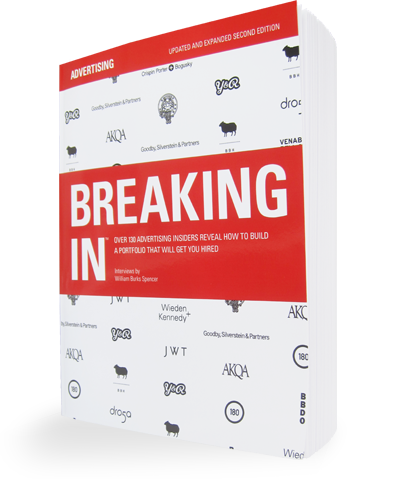If you missed it, check out some great work from Matt Orser.
WS: What do you look for in a student book? And what impresses you?
MO: I want to be jealous. If I see something that makes me think, “Wow, I wish I did that.” That’s it. That’s all I look for. Because if I was inspired enough by one thing that I saw, that would make it memorable and make it good. It seems like it’s easy but it’s not. It’s really hard to do.
WS: Do you think a student book needs to be finished, or could it just be sketches?
MO: I think student books definitely should be as finished as possible. And I think that everything in the book should be very easy to understand. I feel like I see a lot of stuff nowadays where we’re doing a lot more integrated types of campaigns, especially within our books. And it is a trick sometimes to show it in the proper way, and if it is at all confusing, it just loses all of its importance. And that’s why it always has to be really finished, and tight, and solid because I need to be able to just flip through it. No one’s going to spend that much time. I think a book needs to be polished because then you just understand it quicker. That’s it.
WS: Do you think long copy is important?
MO: I’ve always heard from everyone that writers should have long copy in their book and I think that that’s true. I think they should have an element of some copy, and it seems like that should be a requirement. But that’s the same way that art directors should have great, well-designed layouts. That’s the craft of art directors and copy is the craft of writers.
I don’t know if art directors need to have long copy in their book. It would be nice to see how certain art directors treat long copy because I think it’s one of the harder things to approach when you’re an art director. To do something new with it is really cool to see for an art director. I would be impressed by that as much as I’d be impressed by a nifty visual solution. But both in the same book is really strong to me. You can’t just do what you think you’re good at 100 times in a row. You should have serious diversity in your book.
[ … ]
WS: Do you have any tips on how to get into the industry?
MO: There’s the obvious, “Yeah, you have to go to ad school,” which is what a lot of people say. At least get around someone who can help you make a book. All you’ve got to do is make a book. That’s what you do to get into the industry. But the book has got to be good. But, above everything else, if you’re going to get into this industry, you have to just commit. It’s not an industry that you can just try for fun. If you want to be good at advertising, you have to commit right then, and move into your career with that full intention to be good.

Comments are closed.